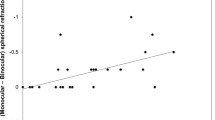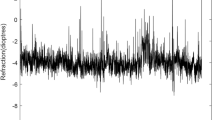Abstract
The steady-state accommodative responses of emmetropes and late-onset myopes was measured for an array of numbers located at +1, +3 and +5 dioptres using an objective infra-red optometer. Responses were compared for passive (reading numbers) and active (adding numbers) conditions. For the passive condition, the late-onset myopes showed a significantly lower accommodative response than the emmetropic group. No significant differences were found between the two groups for the active condition. Ocular biometric characteristics were also measured in emmetropes, late-onset myopes and early-onset myopes using keratometry and ultrasonography. No significant differences in corneal curvature, anterior chamber depth and crystalline lens thickness were found between the groups. Late-onset myopes exhibited significantly deeper vitreous chambers than emmetropes, which more than accounted for the difference in refractive error between the two refractive groups. We conclude that, while significant differences exist in the accommodative responses of late-onset myopes and emmetropes, late-onset myopia is due predominantly to elongation of the vitreous chamber.
Similar content being viewed by others
References
Goss DA, Winkler RL. Progression of myopia in youth: age of cessation. Am J Optom Physiol Opt 1983; 60: 651–8.
Working Group on Myopia Prevalence and Progression, Committee on Vision, Commission on Behavioural and Social Sciences and Education, National Research Council. Myopia: Prevalence and Progression. Washington, DC: National Academy Press, 1989.
Grosvenor T. A review and a suggested classification system for myopia on the basis of age-related prevalence and age of onset. Am J Optom Physiol Opt 1987; 64: 545–54.
Hoogerheide I, Rempt F, Hoogenboom WPH. Acquired myopia in young pilots. Ophthalmologica 1971; 163: 209–15.
Goss DA, Erickson P, Cox VD. Prevalence and pattern of adult myopia progression in a general optometric practice population. Am J Optom Physiol Opt 1985; 62: 470–7.
Shotwell AJ. Plus lenses, prisms and bifocal effects on myopia progression in military students. Am J Optom Physiol Opt 1981; 58: 349–54.
McBrien NA, Millodot M. Amplitude of accommodation and refractive error. Invest Ophthal Visual Sci 1986; 27: 1187–90.
McBrien NA, Millodot M. The effect of refractive error on the accommodative response gradient. Ophthal Physiol Opt 1986; 6: 145–9.
Bullimore MA, Gilmartin B. Aspects of tonic accommodation in emmetropia and late-onset myopia. Am J Optom Physiol Opt 1987; 64: 499–503.
McBrien NA, Millodot M. The relationship between tonic accommodation and refractive error. Invest Ophthal Visual Sci 1987; 28: 997–1004.
Bullimore MA, Boyd T, Mather HE, Gilmartin B. Near retinoscopy and refractive error. Clin Exp Optom 1988; 71: 114–8.
Bullimore MA, Gilmartin B. The accommodative response, refractive error and mental effort: 1. The sympathetic nervous system. Doc Ophthmol 1988; 69: 385–97.
Sorsby A, Benjamin B, Sheridan M. Refraction and its components during growth of the eye from age of three. Medical Research Council Special Report Series, No 301. London: HMSO, 1961.
Larsen JS. The sagittal growth of the eye, Part I: Measurement of the depth of the anterior segment from birth to puberty. Acta Ophthalmol 1971; 49: 239–62.
Larsen JS. The sagittal growth of the eye, Part II: Ultrasonic measurement of the axial diameter of the lens and anterior segment from birth to puberty. Acta Ophthalmol 1971; 49: 427–40.
Sorsby A, Leary GA. A longitudinal study of refraction and its components during growth. Medical Research Council Special Report Series No 309. London: HMSO, 1970.
Larsen JS. The sagittal growth of the eye, Part III: Ultrasonic measurement of the posterior segment from birth to puberty. Acta Ophthalmol 1971; 49: 441–53.
Goldschmidt E. On the etiology of myopia. Acta Ophthalmol Suppl 1968; 98: 1–172.
Adams AJ. Adult onset myopia: evidence for axial length elongation not corneal curvature increase as the basis. Am J Optom Physiol Opt 1987; 64: 150–2.
McBrien NA, Millodot M. A biometric investigation of late onset myopic eyes. Acta Ophthalmol 1987; 65: 461–8.
McBrien NA, Millodot M. A clinical evaluation of the Canon Autoref R-1. Am J Optom Physiol Opt 1985; 62: 786–92.
Bullimore MA, Gilmartin B, Hogan RE. Objective and subjective measurement of tonic accommodation. Ophthal Physiol Opt 1986; 6: 57–62.
Pugh JR, Winn B. Modification of the Canon Autoref R-1 for use as a continuously recording infra-red optometer. Ophthal Physiol Opt 1988; 8: 460–4.
Gilmartin B, Bullimore MA. Sustained near-vision augments inhibitory sympathetic innervation of the ciliary muscle. Clin Vision Sci 1987; 1: 197–208.
Schor CM, Kotulak JC, Tsuetaki T. Adaptation of tonic accommodation reduces accommodative lag and is masked in darkness. Invest Ophthalmol Vis Sci 1986; 27: 820–7.
Malmstrom FV, Randle RJ, Murphy MR, Reed LR, Weber RJ. Visual fatigue: The need for an integrated model. Bull Psychonom Soc 1981; 17: 183–6.
Willemsen EW. Understanding Statistical Reasoning. San Francisco, CA: Freeman, 1974.
Jones R. Do women and myopes have larger pupils? Invest Ophthalmol Visual Sci 1990; 31: 1413–5.
Heath GG. The influence of visual acuity on the accommodative response. Am J Optom Arch Am Acad Optom 1956; 33: 513–24.
Johnson CA. Effects of luminance and stimulus distance on accommodation and visual resolution. J Opt Soc Am 1976; 66: 138–42.
Charman WN, Tucker J. Dependence of accommodation response on the spatial frequency spectrum of the observed object. Vision Res 1977; 17: 129–39.
Charman WN. Static accommodation and the minimum angle of resolution. Am J Optom Physiol Opt 1986; 63: 915–21.
Owens DA, Leibowitz HW. The fixation point as a stimulus for accommodation. Vision Res 1975; 15: 1161–3.
Fincham EF, Walton J. The reciprocal actions of accommodation and convergence. J Physiol 1957; 137: 488–588.
Baldwin WR. A review of statistical studies of relations between myopia and ethnic, behavioral and physiological characteristics. Am J Optom Physiol Opt 1981; 58: 516–27.
Rosenfield M, Gilmartin B. Effect of a near-vision task on the response AC/A ratio of a myopic population. Ophthal Physiol Opt 1987; 7: 225–33.
Young FA, Singer RM, Foster D. The psychological differentiation of male myopes and non-myopes. Am J Optom Physiol Opt 1975; 52: 679–86.
Baldwin WR. Accommodative characteristics of a group of myopic adults. Am J Optom Archs Am Acad Optom 1965; 42: 237–43.
Gawron VJ. Differences among myopes, emmetropes, and hyperopes. Am J Optom Physiol Opt 1981; 58: 753–60.
Bullimore MA, Conway R, Nakash A. Myopia in optometry students: Family history, age of onset and personality. Ophthal Physiol Opt 1989; 9: 284–8.
Van Alphen GWHM. On emmetropia and ametropia. Ophthalmologica Suppl 1961; 142: 1–92.
Gilmartin B, Bullimore M, Rosenfield M, Winn B. Ciliary muscle tonus and innervation in late-onset myopia. Invest Ophthalmol Visual Sci Suppl 1989; 30: 325.
Bennett AG. A method for determining the equivalent powers of the eye and its crystalline lens without resort to phakometry. Ophthal Physiol Opt 1988; 8: 53–9.
Dunne MCM, Barnes DA, Royston JM. An evaluation of Bennett's method for determining the equivalent powers of the eye and its crystalline lens without resort to phakometry. Ophthal Physiol Opt 1989; 9: 69–71.
Van Alphen G. Choroidal stress and emmetropization. Vision Res 1986; 26: 723–34.
Author information
Authors and Affiliations
Rights and permissions
About this article
Cite this article
Bullimore, M.A., Gilmartin, B. & Royston, J.M. Steady-state accommodation and ocular biometry in late-onset myopia. Doc Ophthalmol 80, 143–155 (1992). https://doi.org/10.1007/BF00161240
Accepted:
Issue Date:
DOI: https://doi.org/10.1007/BF00161240




